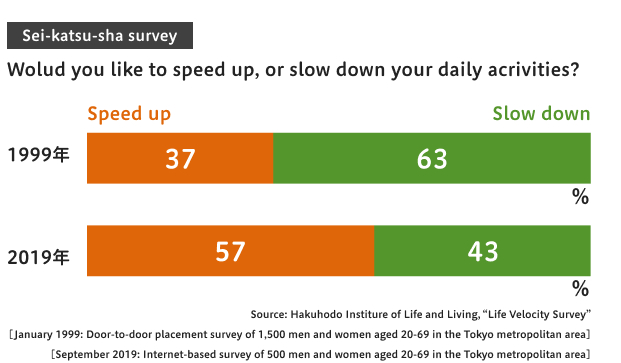MIRAI Expo 2020
Where All My Time Goes.
Mirai Expo seeks to present a futuristic view of Japan 10 to 15 years ahead under various themes. This year’s theme focuses on “time.”
Sei-katsu-sha today have much more time on their hands with the advent of a hyperaged society and the “age of 100-year life.” At the same time, we are trying hard to eliminate wasted time with workstyle reforms and time-saving goods, among other things. Faced with the question of how to spend time, a new tribe of sei-katsu-sha is emerging, characterized by novel, iconoclastic ways of spending time. We explored how those men and women might transform society in the years ahead.
Introduction
Genesis of “time”
Evolving from ancient times when humans used to organize their activities in the village in line with the sleep-wake cycle of their cattle, time has become a common way to control factory workers and production efficiency since the industrial revolution in the late 18th century. In other words, modern history has been marked by the need to synchronize our personal “time axis” to that of society.
Part 1
Changing the common perception of “time”
That common perception has been changing recently. But how?
-
Changing behavior
As individuals can now decide on the timing, length and scope of action at their discretion, the “peaks,” “clumps” and “borders” of action times have been eliminated. ⇒ Sei-katsu-sha have started to free themselves from the “time axis” of society.
-
Changing attitudes
The Life Velocity survey, conducted by the Hakuhodo Institute of Life and Living in 1999 and 2019, found that the trend in people’s desire to speed up the velocity of life activities (work, family chores, play, etc.) had reversed over the 20 years. Indeed, the findings indicate that sei-katsu-sha are increasingly inclined to speed up their life at their own initiative, rather than being obliged to do so, as they liberate themselves from the time axis of society. ⇒ Sei-katsu-sha have come to feel they are controlling, rather than being controlled by time.

-
Generation driving the change
A closer look at quantitative surveys indicates that people in their 20s are at the center of this change. Indeed, the Life Velocity Survey shows that as many as 71% of respondents in their 20s want to “speed up” their life. People in their 20s stand out in their answers to other questions as most of them want to “get things done efficiently” (63%, 17 percentage points higher than the average) and “do multiple tasks simultaneously” (50.0%, 19 points higher than the average).
The Hakuhodo Institute of Life and Living decided to call these people in their 20s who are focused on improving “time performance” by actively speeding up the rhythm of life or spending time in a multi-layered way “new time-conscious sei-katsu-sha.”
Part 2
New time-conscious sei-katsu-sha are on their way.
How do the new time-conscious sei-katsu-sha spend their time? We have summarized their behavior into three characteristics based on the results of qualitative surveys including on-the-street and in-depth interviews.
Three characteristics of new time-conscious sei-katsu-sha
-
Characteristic 1: Look for enriching experiences, rather than simply saving time.
- Minimize the risk of wasting time in view of the sheer volume of information to be handled.
- Pack as much information and passion as possible into a limited time to make it more enjoyable.
-
Characteristic 2: Reorganize space and relationships to make the most of the time available.
- Change the mode of time by changing places.
- Increase the creativity of time by changing partners.
-
Characteristic 3: Align society with their own time axis.
- Have discretionary and “editing” power to shape their own time axis.
- Limit synchronization to defend their time axis.
New time-conscious sei-katsu-sha are controlling their time to satisfy their desires, thereby achieving ideal time performance for themselves. The way of life and the personality of individuals are expected to be defined by “time style,” or how they shape their own time.
Part 3
Landscape of “time” in the future
Possible life of new time-conscious sei-katsu-sha in 2030.
Landscape as inspired by issues related to “time”
-
Issue of a widening “time divide”
Differences in financial resources and technological literacy will result in a “time divide,” requiring measures to ensure the coexistence of people on both sides of the divide and closing the gap.
Landscape of 2030: A “velocity tax” will be imposed on devices and tools that facilitate efficient use of time to finance measures or redistribute resources for closing the gap. -
Issue of drastic changes in “time etiquette”
People will have completely different “time etiquette,” or senses and attitudes toward spending time, depending on the generation, locality, profession, etc., and thus it will be necessary to recognize, reconcile and close the gaps.
Landscape of 2030: Services will emerge to reconcile the differences in time axis, including by arranging appointments with interlocutors who have different etiquettes using AI. -
Issue of extreme “sync-lessness”
The emergence of extremely “sync-less” sei-katsu-sha, who reject even partial synchronization, will require a new form of synchronization to avoid social isolation and disconnectedness.
Landscape of 2030: “Mega-synchronization” will be in place to engage all kinds of people in an ultralong-term social project like the Sagrada Familia.
Conclusion
New sphere of time economy created by new time-conscious sei-katsu-sha
Businesses will be increasingly required to propose new combinations of time (when), place (where) and occasion (what), or “redesign TPO.”
Time will be more amenable to extension, consolidation and division going forward (right column in the figure below). A template to inspire business changes may be developed by combining those actions with routine activities (left column in the figure below).

